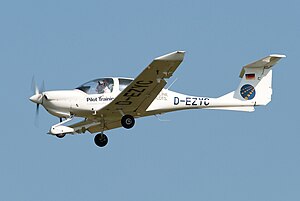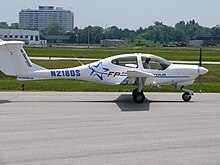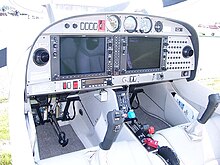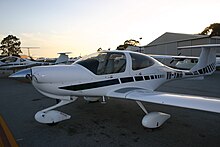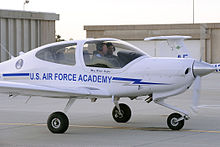
The Piper PA-28 Cherokee is a family of two-seat or four-seat light aircraft built by Piper Aircraft and designed for flight training, air taxi and personal use. The PA-28 family of aircraft comprises all-metal, unpressurized, single piston-engined airplanes with low-mounted wings and tricycle landing gear. They have a single door on the right side, which is entered by stepping on the wing.

The Cessna 172 Skyhawk is an American four-seat, single-engine, high wing, fixed-wing aircraft made by the Cessna Aircraft Company. First flown in 1955, more 172s have been built than any other aircraft. It was developed from the 1948 Cessna 170 but with tricycle landing gear rather than conventional landing gear. The Skyhawk name was originally used for a trim package, but was later applied to all standard-production 172 aircraft, while some upgraded versions were marketed as the Cutlass.

The Thielert Centurion is a series of diesel cycle aircraft engines for general aviation originally built by Thielert, which was bought by Aviation Industry Corporation of China's Tecnify Motors subsidiary and is currently marketed by Continental Motors. They are based on heavily modified Mercedes-Benz automotive engines.
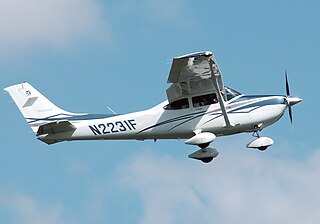
The Cessna 182 Skylane is an American four-seat, single-engined light airplane built by Cessna of Wichita, Kansas. It has the option of adding two child seats in the baggage area.

The Beechcraft Musketeer is a family of single-engined, low-wing, light aircraft that was produced by Beechcraft. The line includes the Model 19 Musketeer Sport, the Model 23 Musketeer, Custom and Sundowner, the Model 23-24 Musketeer Super III the retractable gear Model 24-R Sierra and the military CT-134 Musketeer.
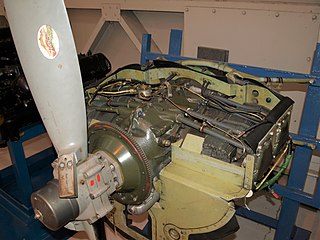
The Lycoming O-360 is a family of four-cylinder, direct-drive, horizontally opposed, air-cooled, piston aircraft engines. Engines in the O-360 series produce between 145 and 225 horsepower, with the basic O-360 producing 180 horsepower.

The Diamond DV20/DA20 Katana is an Austrian-designed two-seat general aviation light aircraft. Developed and manufactured by Diamond Aircraft, it was originally produced in Austria as the DV20.
Diamond Aircraft Industries is a European manufacturer of general aviation aircraft and motor gliders, based in Austria. It has been a subsidiary of the Chinese company Wanfeng Aviation since 2017. It is the third largest manufacturer of aircraft for the general aviation sector, and has manufacturing facilities in Wiener Neustadt, Lower Austria, and in London, Ontario, Canada, as well as further production lines operated as joint ventures in other nations, such as China.

The aircraft diesel engine or aero diesel is a diesel-powered aircraft engine. They were used in airships and tried in aircraft in the late 1920s and 1930s, but were never widely adopted until recently. Their main advantages are their excellent specific fuel consumption, the reduced flammability and somewhat higher density of their fuel, but these have been outweighed by a combination of inherent disadvantages compared to gasoline-fueled or turboprop engines. The ever-rising cost of avgas and doubts about its future availability have spurred a resurgence in aircraft diesel engine production in the early 2010s.

The Diamond DA42 Twin Star is a four seat, twin engine, propeller-driven airplane developed and manufactured in Austria and Canada by Diamond Aircraft Industries, an Austrian subsidiary of China-based Wanfeng Aviation. It was Diamond's first twin engine design, as well as the first new European twin-engine aircraft in its category to be developed in over 25 years. In 2004, the DA42 became the first diesel-powered fixed-wing aircraft to perform a non-stop crossing of the North Atlantic.
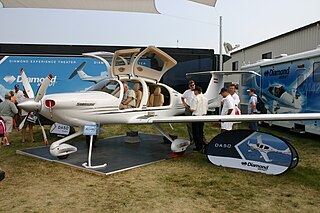
The Diamond DA50 is a five seat, single-engine, composite aircraft designed and built by Diamond Aircraft Industries. First shown in 2006, it made its maiden flight on 4 April 2007. The project has been proposed to be powered by several different engines, but was certified on 9 September 2020 with the Continental CD-300 diesel.

The Rockwell Commander 112 is an American four-seat single-engined general aviation aircraft designed and built by North American Rockwell starting in 1972. In 1976, they introduced the turbocharged version 112TC and mounting a larger engine with other minor improvements they introduced the Rockwell Commander 114. A total of approximately 1,300 examples of all models were produced before the production line shut down in 1980. In 1981, the type certificate owner was Gulfstream Aerospace, but that company had no interest in single-engine piston production.

The Lycoming IO-390 engine is a horizontally opposed, four-cylinder aircraft engine, manufactured by Lycoming Engines.

The Socata TB is a series of light single-engine piston aircraft developed and manufactured by French aircraft company SOCATA. The letters TB within the designation stand for Tarbes, the French city where the aircraft series is manufactured. The TB series planes have come to be known as the "Caribbean Planes", due to the island naming convention adopted for the various models, though they are not often seen flown in that region.

The Flight Design C4 is a German four seat, high-wing, single engine light aircraft under development by Flight Design of Leinfelden-Echterdingen.
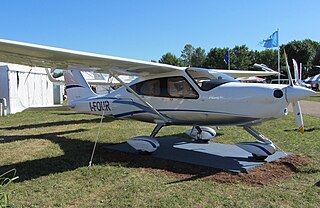
The Tecnam 2010 is a four-seat, high wing, single engine light aircraft of mixed metal and carbon-fiber-reinforced polymer construction. Designed and built in Italy, it was first presented in public in April 2011.
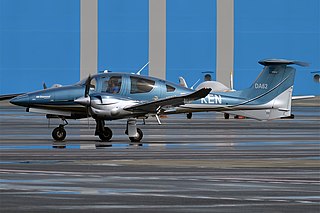
The Diamond DA62 is a five- to seven-seat, twin-engine light aircraft produced by Diamond Aircraft Industries and first announced in March 2012.

The CubCrafters CC19 XCub is an American light aircraft, designed and produced by Cub Crafters of Yakima, Washington, introduced in June 2016. The aircraft is supplied complete and ready-to-fly.

The CubCrafters CC18-180 Top Cub is an American light aircraft designed and produced by CubCrafters of Yakima, Washington, introduced in 2004. The aircraft is type certified and supplied complete and ready-to-fly.

The Vulcanair V1.0 is an Italian light aircraft, designed and produced by Vulcanair of Casoria, introduced at the AERO Friedrichshafen show in 2014. The aircraft is type certified by the European Aviation Safety Agency and the US Federal Aviation Administration and is supplied complete and ready-to-fly.
